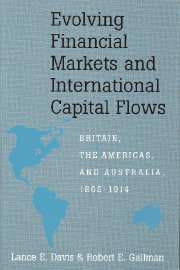 Evolving Financial Markets and International Capital Flows
Evolving Financial Markets and International Capital Flows Book contents
- Frontmatter
- Contents
- 1 Institutional invention and innovation: Foreign capital transfers and the evolution of the domestic capital markets in four frontier countries: Argentina, Australia, Canada, and the United States, 1865–1914
- 2 The United Kingdom
- 3 International capital movements, domestic capital markets, and American economic growth, 1865–1914
- 4 Domestic savings, international capital flows, and the evolution of domestic capital markets: The Canadian experience
- 5 Domestic saving, international capital flows, and the evolution of domestic capital markets: The Australian experience
- 6 Argentine savings, investment, and economic growth before World War I
- 7 Lessons from the past: International financial flows and the evolution of capital markets, Britain and Argentina, Australia, Canada, and the United States before World War I
- 8 Skipping ahead: The evolution of the world's finance markets 1914–1990 – A brief sketch
- 9 Lessons from the past
- Bibliography
- Index
4 - Domestic savings, international capital flows, and the evolution of domestic capital markets: The Canadian experience
Published online by Cambridge University Press: 18 August 2009
- Frontmatter
- Contents
- 1 Institutional invention and innovation: Foreign capital transfers and the evolution of the domestic capital markets in four frontier countries: Argentina, Australia, Canada, and the United States, 1865–1914
- 2 The United Kingdom
- 3 International capital movements, domestic capital markets, and American economic growth, 1865–1914
- 4 Domestic savings, international capital flows, and the evolution of domestic capital markets: The Canadian experience
- 5 Domestic saving, international capital flows, and the evolution of domestic capital markets: The Australian experience
- 6 Argentine savings, investment, and economic growth before World War I
- 7 Lessons from the past: International financial flows and the evolution of capital markets, Britain and Argentina, Australia, Canada, and the United States before World War I
- 8 Skipping ahead: The evolution of the world's finance markets 1914–1990 – A brief sketch
- 9 Lessons from the past
- Bibliography
- Index
Summary
Introduction
Patterns of growth, 1867–1914
In 1841 the heretofore separate provinces of Upper and Lower Canada were brought together in a legislative union creating what might be termed the first Canadian confederation. In 1848 the citizens of Nova Scotia were granted responsible government. That status was confirmed to Canadian residents (residents of what had been Upper and Lower Canada) a year later, and in the ensuing years it was introduced into New Brunswick, Prince Edward Island, and Newfoundland. In 1867 Nova Scotia, New Brunswick, and the now linked colonies of Upper and Lower Canada (taking the provincial names of Ontario and Quebec) joined together in a far more extensive federal union. The new commonwealth comprised 384,598 square miles; within a half dozen years it was augmented by the vast territories of the Hudson's Bay Company, British Columbia, and Prince Edward Island, the whole amounting to 3,357,348 square miles, an area almost nine times as large as was contained in the original Confederation.
The act of the British Parliament that created the Confederation was a constitutional document. Among its other features, it distributed powers and tax sources among the federal, provincial, and local governments, and, in order to open the domestic market, forbade interprovincial tariffs. The chief responsibility of the federal government was to promote peace, order, and good government; and a series of Canadian politicians have taken these goals to include policies that promote economic growth.
- Type
- Chapter
- Information
- Evolving Financial Markets and International Capital FlowsBritain, the Americas, and Australia, 1865–1914, pp. 345 - 470Publisher: Cambridge University PressPrint publication year: 2001


